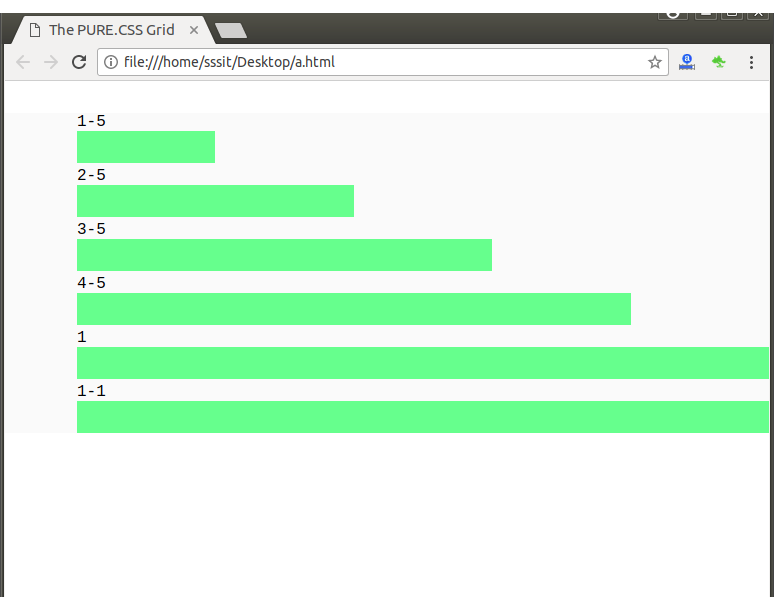

Pure.CSS facilitates the 4 different keywords, sm, md, lg, xl & these keywords are attached with the Pure grid unit classes (pure-u) that can be It has an internally 12 column mobile-first fluid grid that helps responsive designs for small, large, and medium display screen sizes. Responsive layout is the built-in characteristic of Pure.CSS.
#Pure responsive grids pure css how to
How To Create Responsive Data Tables With CSS Grid.
#Pure responsive grids pure css full

Now, Let us see one example for the Pure Responsive Grids. The below provided link should be used between head tags and before the project specific style sheets. For which, we need to use separate CSS file by using the below CDN link. Pure CSS – Responsive Grids: Pure has provided the mobile prioritized grid system which will not come with pure.css file. We’re coding for mobile first so we assume the user is using a small screen. The only change you’ll notice so far is the gap between elements.cards And so on. Units have various class names that represent their widthsĪdd a width, margin, and some CSS Grid Layout styles to the parent. Pure Grids consist of two types of classes: the grid class (pure-g) and unit classes (pure-u or pure-u-*) The widths of the units are fractions 1. There are a few simple concepts to keep in mind: Grid classes vs. item-container and applying it to the (the red box).item-container Finishing NotesĪccessibility is an area that wasn’t considered at all and may have some space for improvement.Pure Grids are easy to work with, and very powerful. Let’ s start by setting the list as a grid container by defining a class called. The red box is a grid container for each row, and the blue box is a container for each column group that wraps. In order to make columns wrap, multiple grid containers are defined as a hierarchy. This layout has the luxury of being able to see as many items (rows) as possible. The basic idea here is to display all attributes of the item as a normal table, display width permitting. Now, it’s time to start talking about styling the items with CSS Grid. I will come back to this in the next section on the topic of styling.Īs for the actual data inside the element, the first item in the list is the header, and the rest of the items are the actual data. This structure will be used when defining how the data should be laid out. The key here is to express semantically similar attributes as a hierarchy of s. Vanilla s are used to express item attributes since HTML5 does not define an appropriate tag for this. Also, since tables are often used to supplement textual descriptions, it seems natural to enclose this in a section, but this would depend on the context of how the table data is being used. Let’s start by redefining how table data should be expressed in HTML.Īs stated earlier, since table data is essentially an ordered collection of items, it seems natural to use ordered lists. In terms of hacks, you can alter the display property of tables and use any layout you can do with CSS in general, but that doesn’t seem semantically correct. This may be sufficient for usage by a screen that fits the whole table width, but in reality, this does not apply for the myriad of devices that exist today.

When using HTML tables, the layout of the data is hardcoded as rows and columns (e.g. The format gives you a birds-eye view to quickly grasp and examine large quantities of data.įor example, here’s a hypothetical table of purchase order details, that you may see in a purchasing application.Īn item, in this case, is a purchase order detail, that has attributes such as part number, part description, etc. Items are laid out in rows, with the same data attributes in the same columns, with the rows often sorted with one or more sortable attributes. Starting with the basics, a table in HTML is a layout format for displaying collections of items through a matrix of rows and columns. “Really Responsive Tables using CSS3 Flexbox” by Vasan Subramanian shows an idea of wrapping columns, implemented with Flexbox.Įven though many interesting ideas have been proposed, libraries like bootstrap opt for horizontal scrolling for small screens.Īs we now have CSS Grid, I think we could have a better common alternative to horizontal scrolling. “Responsive Table Data Roundup” first published in 2012 by Chris Coyier, has things summarized very neatly (including a 2018 update). Responsive tables aren’t a new topic, and there are many solutions that have already been proposed. A Little History of Responsive HTML Tables


 0 kommentar(er)
0 kommentar(er)
